|
Teck
Cominco Riverbank Restoration Project
Go To:
Implementation/Construction
Repair
and Maintenance
Monitoring
Results
Compost Tea
Application
Introduction:
In December of 2004 Terra Erosion Control Ltd,
in association with Amec Earth Environmental, competitively
won the contract to develop a prescription and cost
estimate for the riverbank restoration project. In 2005
Terra Erosion Control Ltd was retained to implement
the prescribed treatments from 2006 to 2008.
Location:
Riverbank
and hillside adjacent to the Teck Cominco lead-zinc
smelter and the Columbia River in Trail, BC.
Client:
Teck
Cominco Metals Limited
Objective:
Establish vegetation on the hillside and adjacent riverbank
below the lead-zinc smelter in order to reduce/control
soil erosion and improve visual, wildlife and fish habitat
values.
Teck Cominco
and it's predecessor have operated a smelter in Trail
since the later 1800's. Evidence of the long operation
can be found on the slope below the smelter with the
presence of bricks, smelter slag, metal bits and a variety
of other materials. A
number of previous attempts to re-vegetate the area
have been made; in general these have been met with
poor to, at best, moderate success. The current project,
which uses soil bioengineering techniques, is expected
to yield a more satisfactory solution.
For
this project the hillside below the smelter was divided
into four treatment units and the adjacent riverbank
into five treatment sections. Live cuttings used in
the soil bioengineering structures were collected locally
starting in the fall of 2005.
|
|
Tech Cominco
smelter, 1930's (photo: Ministry of Environment, Nelson,
B.C.)
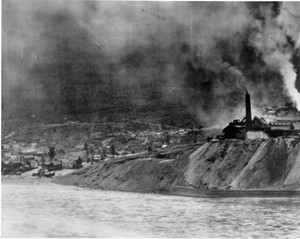
Hillside
Unit 1 and riverbank 2004, pre-treatment (photo: Amec
Earth and Env.)
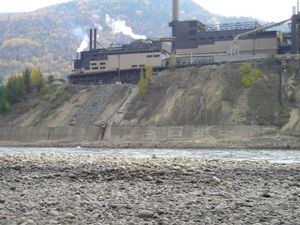
|
Hillside Units 1 and 2
and riverbank 2004, pre-treatment (photo: Amec Earth
and Env.)
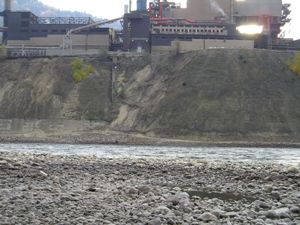
|
Hillside Units 2 and 3
and riverbank 2004, pre-treatment (photo: Amec Earth
and Env.)
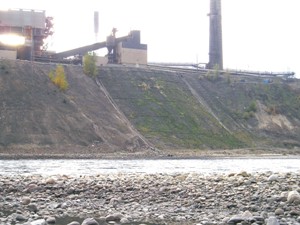
|
| |
Hillside
Units 3 and 4 and riverbank 2004, pre-treatment (photo:
Amec Earth and Env.)
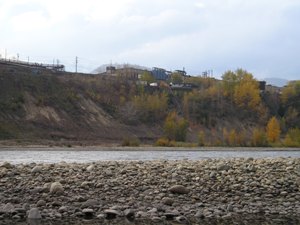
|
2005 Aerial
photo of hillside, pre-treatment (photo: Teck Cominco
Metals Ltd.)
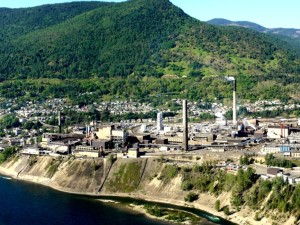
|
| |
|
Implementation/Contruction:
Riverbank
Sections: In
the spring and fall of 2006 soil bioengineering structures
were installed along the Columbia River . These consisted
primarily of brush layers, but also brush sills in combination
with live fascines and vegetated rip-rap. The species
component of these structures consisted of a mixture
of Willow ( Salix bebbiana / scouleriana / exigua
), Black Cottonwood ( Populus balsamifera ssp.
trichocarpa ), Red-Osier Dogwood ( Cornus stolonifera
), and a small amount of Pacific Willow ( Salix
lucida ssp. lasiandra ). Planting was machine-assisted
using an excavator.
A
section of the brush sill / fascine structures was destroyed
in spring 2008 due to extension of the riverbank road.
During construction a vegetated rip-rap application
was installed along this new section of road containing
a high component of Pacific Willow (medium sized tree).
It is intended to provide a visual filter for the wall
located behind the road.
A
total of approximately 27,000 live cuttings were planted
in Sections 1 to 3A, between 2006 and 2008, over an
area of 0.5 ha.
| |
|
Vegetated
riprap installation riverbank,
spring
2006
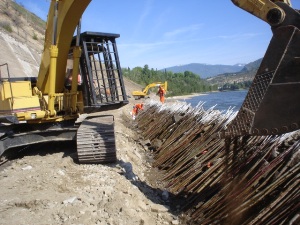
|
Machine assisted brush layers installation riverbank,
spring 2006
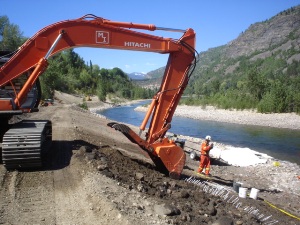
|
| |
|
| Hillside
Units: Installation
of soil bioengineering structures on the hillside
units commenced in fall 2006 (Units 3 and 4),
continued in spring 2007 (Units 2, 3 and 4), and
was completed in spring 2008 (Unit 1). Two small
areas in Unit 4, with a slope gradient less than
40 %, were planted using an excavator. In areas
with slopes greater than 40 % (the bulk of these
units), machine-assisted planting was done using
a walking excavator (Spyder Hoe). On slopes greater
than 60 % this machine was tethered to a skidder
located at the top of the slope. Materials were
either transported up the slope using an overhead
cable system (Units 2 to 4), or lowered down onto
the slope using a cable / buggy system (Unit 1).
The
soil bioengineering structures consist of brush
layers planted using a mixture of Black Cottonwood
and Willow species. Straw wattles were also installed
across the slope between every second brush layer.
These are designed to disperse surface water and
act as sediment traps, reducing the risk of surface
flow leading to rill erosion. The hillside units
were also planted with native shrubs and conifer
trees and hydro-seeded with native grasses. Due
to the dry conditions on this site during the
summer, an irrigation system was installed over
all areas.
In
2007, trials using pulp-mill biosolids as a soil
amendment were carried out in the more contaminated
areas of Unit 3. Due to favourable results obtained
here, this material was used extensively in Unit
1 (2008) during brush layer installation in areas
where the soil had higher levels of contamination.
A total of 300 cubic meters of this material was
applied to this unit.
A
total of approximately 148,000 live cuttings,
11,900 shrubs and tree seedlings were planted
in Units 1 to 4 between 2006 and 2008 over an
area of 3.29 ha.
|
Vegetated riprap
installation riverbank,
spring
2008
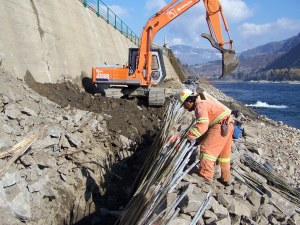
|
Brush
layer planting with excavator in Unit 4, spring
2006
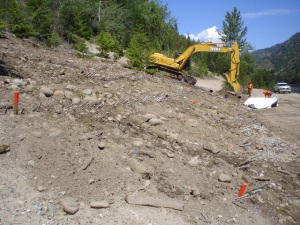
|
| |
|
Brush
layer planting with Spyder Hoe in Unit 3, spring
2007
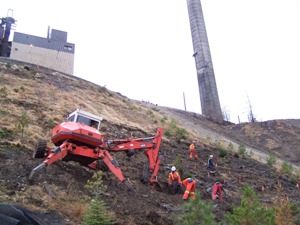
|
Brush
layer planting with Spyder Hoe in Unit 3, spring
2007
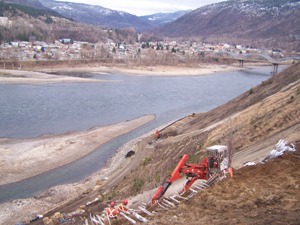
|
Placement
of biosolids on slope on slope of Unit 1, spring
2008
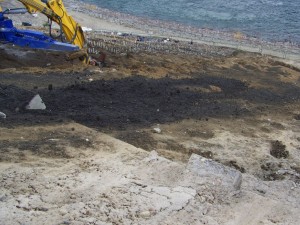
|
Brush
layer planting in Unit 1, spring 2008
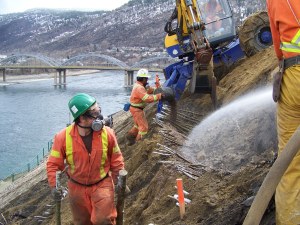
|
| |
|
Brush layer planting in Unit 1, spring 2008
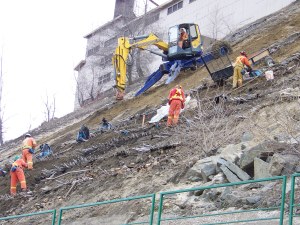
|
Straw wattles installed to control surface erosion
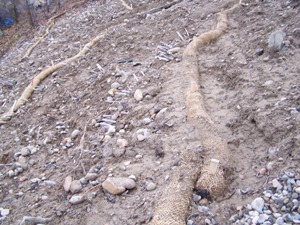
|
| |
|
Cable
system used to transport materials onto
slope
Unit 4, spring 2007
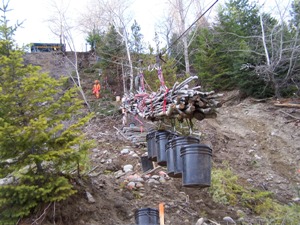
|
Cable/buggy
system used to transport materials
onto
slope Unit 1, spring 2008

|
| |
|
| Repair
and Maintenance:
Due
to surface rill erosion in some areas, resulting
mainly from irrigation water flowing over soil
with poor grass cover (due to soil toxicity),
repair / maintenance treatments were needed on
the hillside units in the spring and fall of 2008.
These consisted primarily of placing coir matting
over critical areas and the installation of additional
straw wattles, some of which included burlap splash
aprons (these aprons improve the effectiveness
of wattles in steep areas).
|
| |
|
Coir
matting placed on critical area at top of slope,
spring 2008
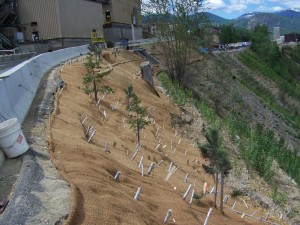
|
Straw
wattles with burlap aprons in Unit 2, September
2008
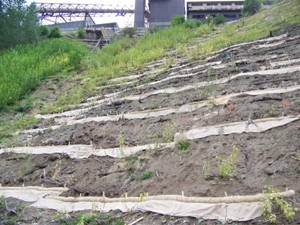
|
| |
|
Straw
wattle with burlap apron, September 2008
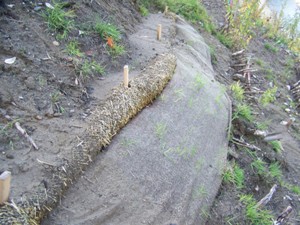
|
| |
|
| Monitoring
Results:
Riverbank
Sections: As
of August 2008, survival and growth of the soil
bioengineering structures installed in the riverbank
sections has been good to excellent overall. In
some areas, however, survival was reduced due
to prolonged river flooding. When the brush layers
were submerged by water during flooding, survival
was still good if the top of growing shoots remained
above the water. Additional monitoring took place until the Fall of 2014. |
Riverbank
Section 1, May 2008
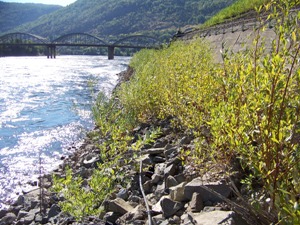
|
Riverbank Section
1 South, summer 2010
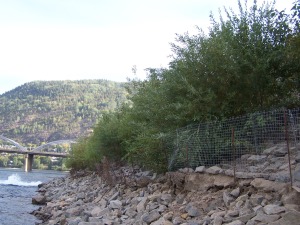
|
| |
|
Riverbank Section 1 North, summer 2010
|
|
|
| |
|
Riverbank Section
1A, summer 2008
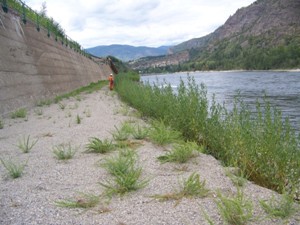
|
| |
|
Riverbank Section 1A South, August 2008 |
|
|
| |
|
Riverbank
Section 2 during flooding, spring 2007
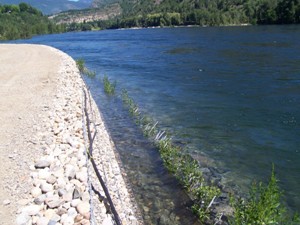
|
Riverbank
Section 2, August 2008
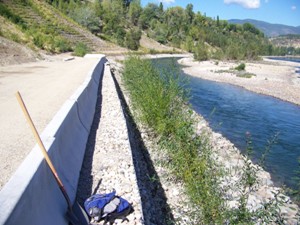
|
| |
|
Riverbank
Section 1 & 2, September 2008
(photo:
Teck Cominco)
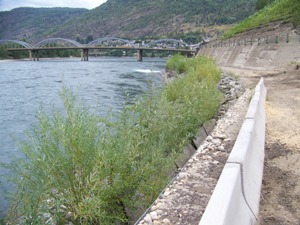
|
Riverbank
Section 3, August 2008
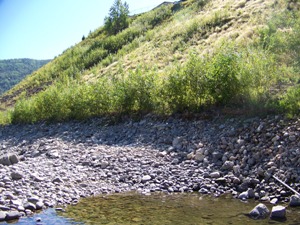
|
| |
|
Riverbank
Section 3 & Unit 4 above road, August 2008
(photo: Teck Cominco)
|
| |
|
| Hillside
Units 2 to 4: Survival
and growth of brush layers planted in Units 2,
3 and 4 was highly variable when assessed in August
2008 (these brush layers had two seasons of growth
at this time). The average survival rate of planted
cuttings, based on data collected in 11 permanent
sampling plots, was 42 %. This value is considered
only a rough estimate, as the S. D. (24 %) and
range (7 % to 86 %) were high. Some areas with
very good survival and growth were present, along
with areas with very poor survival and growth.
High mortality in some areas is thought due to
one or more of the following: high soil metal
concentrations, very hot and dry conditions during
the summer of 2007 combined with poor irrigation
coverage, heavy grass competition, and high soil
salinity levels. |
| |
Hillside
Unit 2, August 2008
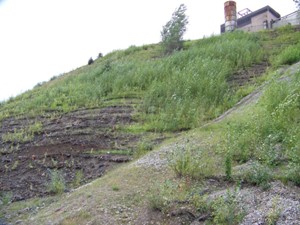
|
Hillside
Unit 3, August 2008
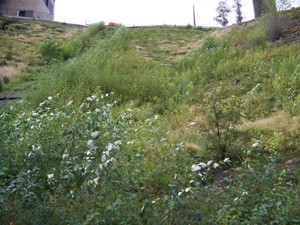
|
| |
|
Hillside
Unit 3, August 2008
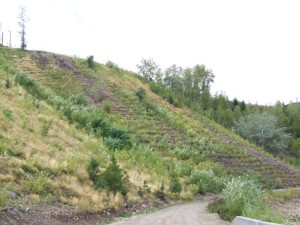
|
Hillside
Units 2 and 3, August 2008
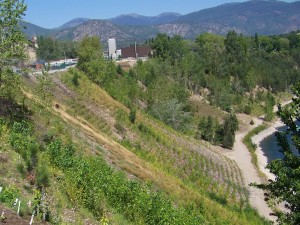
|
| |
|
Hillside
Units 2 and 3, August 2008
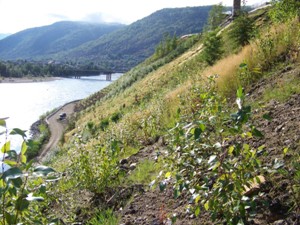
|
Hillside
Unit 4, August 2008
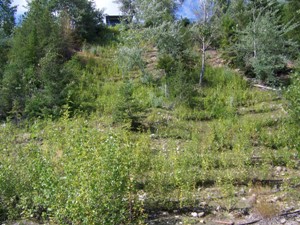
|
| |
|
Hillside
Unit 4, August 2008
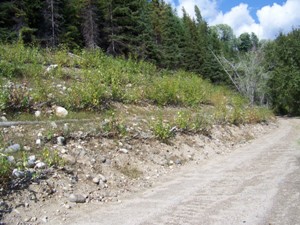
|
| |
|
| Unit
1: Survival
and growth of brush layers in Unit 1 was very
good when assessed in August 2008. Based on data
collected in six permanent sampling plots, the
average survival rate of planted cuttings was
87 % (S.D. 6 %). The application rate of biosolids
in areas with highly toxic soil was highly variable
– this could be seen in the patchy colour (dark
green patches next to chlorotic patches) of foliage
in these areas. |
| |
Hillside
Unit 1 North, August 2008
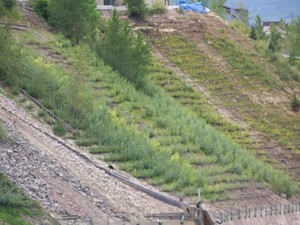
|
Hillside
Unit 1 South, August 2008
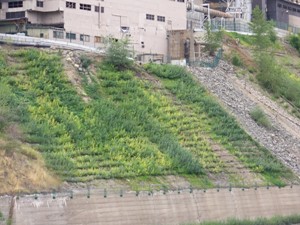
|
| |
|
Hillside
Unit 1, August 2008
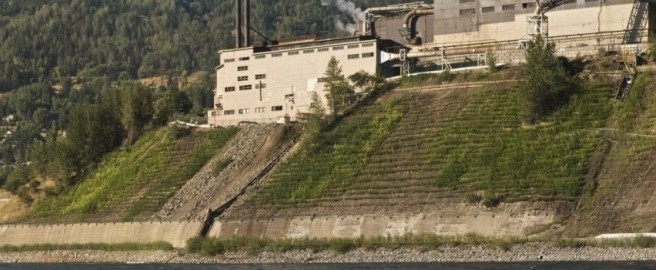
|
| |
Section 1, summer 2010

|
| |
Section 1A, summer 2010

|
| |
Section 1, 1A and 2, summer 2010

|
| |
| Monitoring: Monitoring
of the riverbank and hillside units was completed in the Fall of 2014. |
Unit 1 Fall 2013
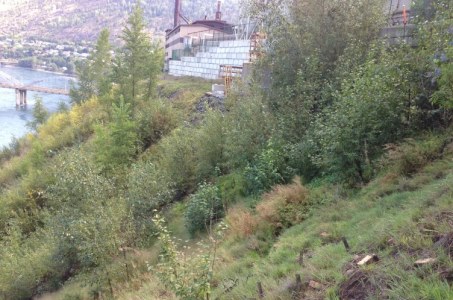
|
| |
|
Unit 1 South, Fall 2014
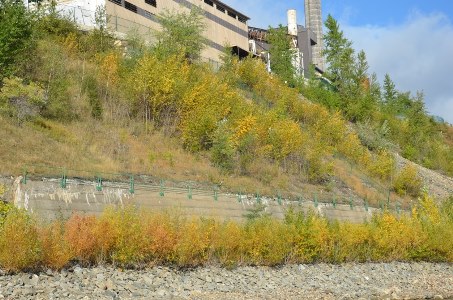
|
| |
|
Unit 3 Fall 2014
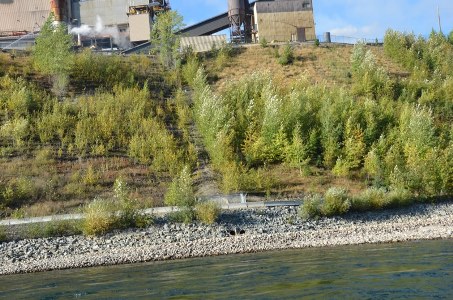
|
|
|
Unit 3 Salix lasiandra Fall 2013
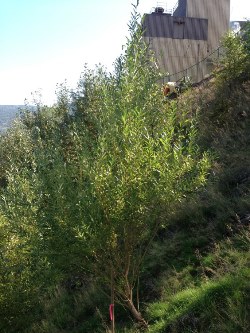
|
Unit 3 Salix lasiandra Fall 2013
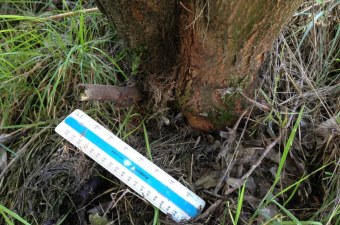
|
| |
|
Section 1 Fall 2014
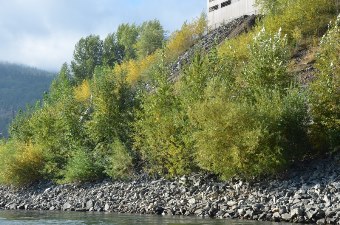
|
Section 1 Fall 2014
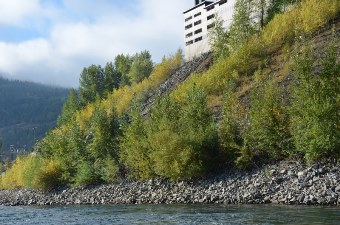
|
| |
|
Section 1 Fall 2014
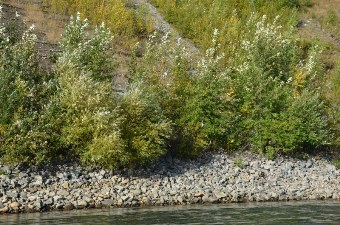
|
Section 1A Fall 2014
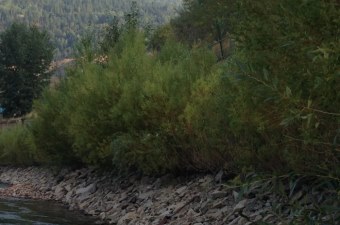
|
| |
|
Section 3 Fall 2014
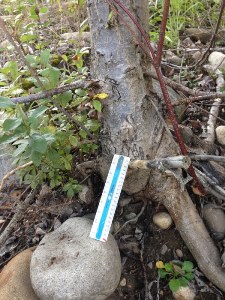
|
Section 3 Fall 2014
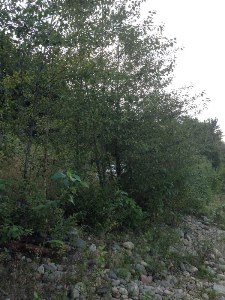
|
| |
|
Before, 2006
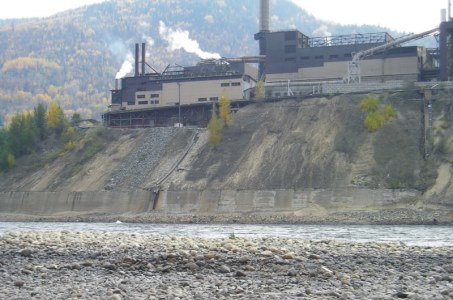
|
| |
|
Hillside Fall 2014
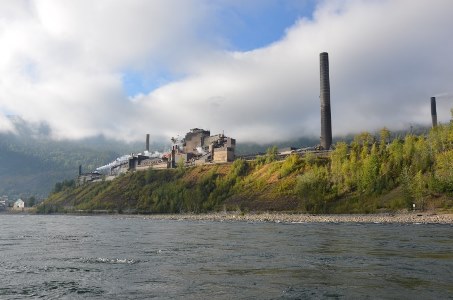
|
| |
|
| Compost
Tea Application:
The
importance of a healthy soil (and foliar) microbial
community to proper ecosystem functioning is well
recognized. Compost tea is a technology developed
to help replenish and restore this community on
lands where it is degraded – plant growth is typically
improved with tea applications containing the
correct mix of beneficial organisms for the vegetation
being grown (Ingham, 2005). Compost Tea production
is a “cold brewing” process, allowing growth of
organisms extracted from the compost. Various
organic foods / organic fertilizers are added
during the brewing process to provide food &
nutrient substrates for the microbial organisms
to grow. The degree to which fungal growth, versus
bacterial growth, is sustained during the brewing
process will depend on the quality of the initial
compost used and the type of food / nutrients
added. It is important that the process remain
aerobic during the brewing process and up until
the tea is applied – if the tea becomes anaerobic,
beneficial organisms (aerobic fungi, protozoa
and nematodes) may be lost, replaced by anaerobic
bacteria and yeasts (Ingham, 2005).
Given
the contaminated nature of the soil and lack of
vegetation in the Riverbank Restoration Project
area prior to the present reclamation treatments,
restoration of the microbial community here is
considered a vital component of the project. To
help achieve this, three compost tea applications
are scheduled for each year until 2011. As of
fall 2008, five compost tea applications have
been done (two in 2007 and three in 2008). The
compost tea is applied through injection into
the irrigation system.
|
Brewing
compost Tea
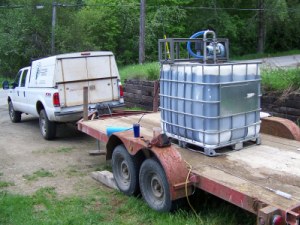
|
Injection
of compost tea into irrigation system
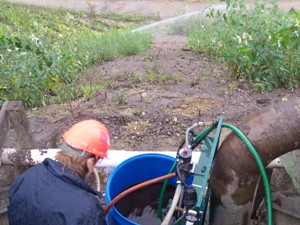
|
| |
|
A
Soil Foodweb Drawing (Drawing: USDA-NRCS)
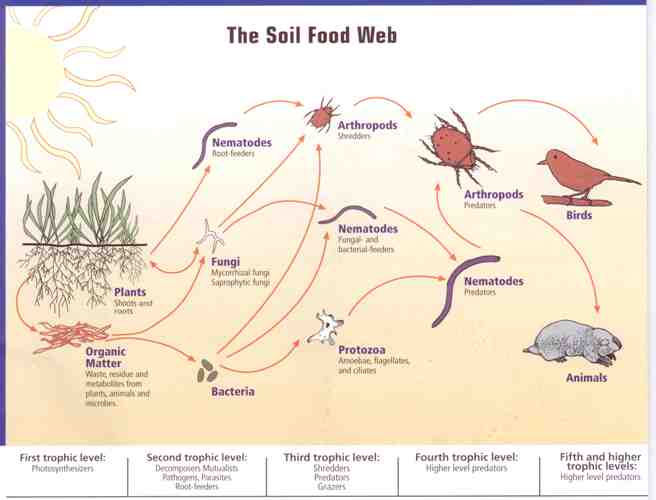
|
| References
Cited:
Ingham,
E. (2005). The Compost Tea Brewing Manual, 5 th edition.
Soil Foodweb Incorporated, Corvallis , Oregon .
|

Copyright © 2010
Terra Erosion Control Ltd.
Riverbank Restoration Project ~ Teck Cominco
|
|
|
|

